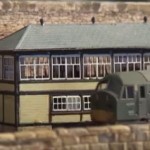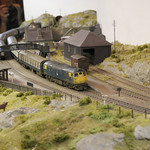“Layout Design for Operation” is the third volume in Atlantic Publishing’s layout planning series.
Unlike it’s two predecessors “Designs for Urban Layouts” and “Mainlines in Modest Spaces”, this one’s not the work of Iain Rice, but’s co-authored instead by Steve Rabone and Trevor Ridley.
Rice’s two books, for all their strengths, concentrated very heavily on 4mm scale British-outline steam-era modelling. Designs for the diesel and electric era, or for N gauge were something of an afterthought. This book, while it might lack Rice’s evocative prose and meticulously-drawn plans, does a lot to redress the balance.
For a start, it doesn’t confine itself to British modelling; more than half the layout designs are of Continental European or North American themes. Then there’s a more or less even balance between OO (or HO) and N. Finally, although there are a few steam age designs, the emphasis is very much on modern diesel and electric operation.
Apart from a couple of big 00 steam-age loft-busters, most are room-sized plans, suitable for fitting in to the sort of space modellers are likely to have available. All are either based on real-life locations, or plausible ‘might have beens’. Just about all of the N gauge ones focus on intensive main line operation rather than shunting; this is the sort of thing N really excels at.
To give a couple of examples, there’s one plan based on the evocative west end of Edinburgh Waverley, not the first I’ve seen published for this location. It’s intended to operated entirely with large numbers of multiple units. It simplifies fiddle yard arrangements by taking advantage of the fact that multiple units don’t have to be remarshalled offstage. A perfect antidote for those that say contemporary DMUs are boring.
Similarly, there’s a spare room (9′ x 6′) plan for Göschenen in Switzerland, focussing on the endless procession of international passenger and freight trains over the steeply graded alpine main line; the operating interest centres on bidirectional running enabling fast trains to overtake slower ones, and the banking of freight trains. This turns what could have been a simple tailchaser into a potentially interesting layout.
Many of the OO and HO plans in contrast are typically L-shaped end-to-end affairs, although the themes vary from Arctic Norwegian termini to through stations on Irish secondary routes. Just about all list the typical rolling stock that’s likely to be needed; did you know northern Norway sees both GM Nohabs and class 66s?
Overall, an excellent book, and very inspirational especially if you’re into either modern traction or N gauge.


